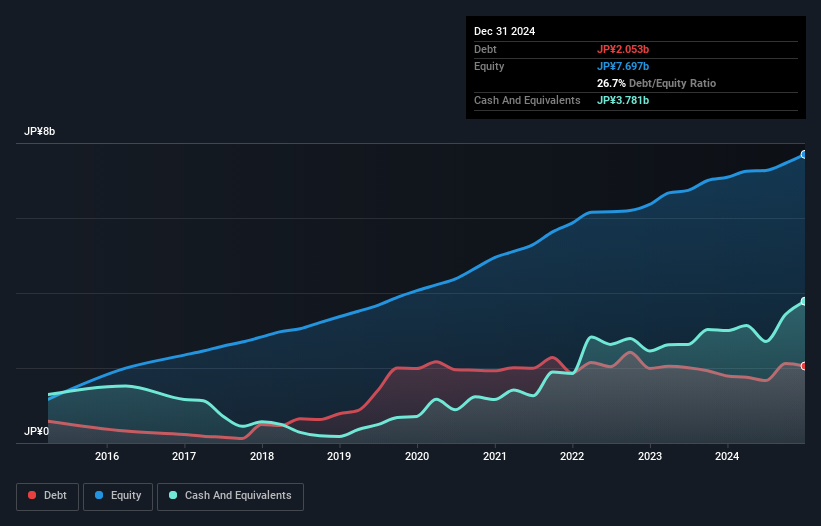
Legendary fund manager Li Lu (who Charlie Munger backed) once said, 'The biggest investment risk is not the volatility of prices, but whether you will suffer a permanent loss of capital.' It's only natural to consider a company's balance sheet when you examine how risky it is, since debt is often involved when a business collapses. We can see that BENEFIT JAPAN Co., Ltd. (TSE:3934) does use debt in its business. But the more important question is: how much risk is that debt creating?
Our free stock report includes 2 warning signs investors should be aware of before investing in BENEFIT JAPAN. Read for free now.Why Does Debt Bring Risk?
Debt is a tool to help businesses grow, but if a business is incapable of paying off its lenders, then it exists at their mercy. If things get really bad, the lenders can take control of the business. However, a more usual (but still expensive) situation is where a company must dilute shareholders at a cheap share price simply to get debt under control. Of course, the upside of debt is that it often represents cheap capital, especially when it replaces dilution in a company with the ability to reinvest at high rates of return. The first step when considering a company's debt levels is to consider its cash and debt together.
How Much Debt Does BENEFIT JAPAN Carry?
As you can see below, at the end of December 2024, BENEFIT JAPAN had JP¥2.05b of debt, up from JP¥1.79b a year ago. Click the image for more detail. However, its balance sheet shows it holds JP¥3.78b in cash, so it actually has JP¥1.73b net cash.

How Strong Is BENEFIT JAPAN's Balance Sheet?
Zooming in on the latest balance sheet data, we can see that BENEFIT JAPAN had liabilities of JP¥2.44b due within 12 months and liabilities of JP¥1.51b due beyond that. Offsetting this, it had JP¥3.78b in cash and JP¥6.32b in receivables that were due within 12 months. So it actually has JP¥6.16b more liquid assets than total liabilities.
This excess liquidity is a great indication that BENEFIT JAPAN's balance sheet is almost as strong as Fort Knox. Having regard to this fact, we think its balance sheet is as strong as an ox. Succinctly put, BENEFIT JAPAN boasts net cash, so it's fair to say it does not have a heavy debt load!
Check out our latest analysis for BENEFIT JAPAN
The good news is that BENEFIT JAPAN has increased its EBIT by 4.1% over twelve months, which should ease any concerns about debt repayment. There's no doubt that we learn most about debt from the balance sheet. But you can't view debt in total isolation; since BENEFIT JAPAN will need earnings to service that debt. So when considering debt, it's definitely worth looking at the earnings trend. Click here for an interactive snapshot.
Finally, a business needs free cash flow to pay off debt; accounting profits just don't cut it. BENEFIT JAPAN may have net cash on the balance sheet, but it is still interesting to look at how well the business converts its earnings before interest and tax (EBIT) to free cash flow, because that will influence both its need for, and its capacity to manage debt. Over the most recent three years, BENEFIT JAPAN recorded free cash flow worth 58% of its EBIT, which is around normal, given free cash flow excludes interest and tax. This free cash flow puts the company in a good position to pay down debt, when appropriate.
Summing Up
While it is always sensible to investigate a company's debt, in this case BENEFIT JAPAN has JP¥1.73b in net cash and a decent-looking balance sheet. So we don't think BENEFIT JAPAN's use of debt is risky. The balance sheet is clearly the area to focus on when you are analysing debt. However, not all investment risk resides within the balance sheet - far from it. For example BENEFIT JAPAN has 2 warning signs (and 1 which is a bit unpleasant) we think you should know about.
At the end of the day, it's often better to focus on companies that are free from net debt. You can access our special list of such companies (all with a track record of profit growth). It's free.
If you're looking to trade BENEFIT JAPAN, open an account with the lowest-cost platform trusted by professionals, Interactive Brokers.
With clients in over 200 countries and territories, and access to 160 markets, IBKR lets you trade stocks, options, futures, forex, bonds and funds from a single integrated account.
Enjoy no hidden fees, no account minimums, and FX conversion rates as low as 0.03%, far better than what most brokers offer.
Sponsored ContentValuation is complex, but we're here to simplify it.
Discover if BENEFIT JAPAN might be undervalued or overvalued with our detailed analysis, featuring fair value estimates, potential risks, dividends, insider trades, and its financial condition.
Access Free AnalysisHave feedback on this article? Concerned about the content? Get in touch with us directly. Alternatively, email editorial-team (at) simplywallst.com.
This article by Simply Wall St is general in nature. We provide commentary based on historical data and analyst forecasts only using an unbiased methodology and our articles are not intended to be financial advice. It does not constitute a recommendation to buy or sell any stock, and does not take account of your objectives, or your financial situation. We aim to bring you long-term focused analysis driven by fundamental data. Note that our analysis may not factor in the latest price-sensitive company announcements or qualitative material. Simply Wall St has no position in any stocks mentioned.
About TSE:3934
Flawless balance sheet and good value.
Market Insights
Community Narratives



